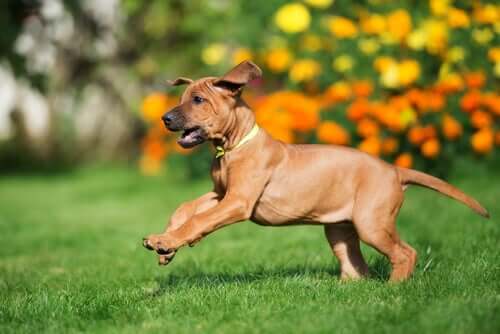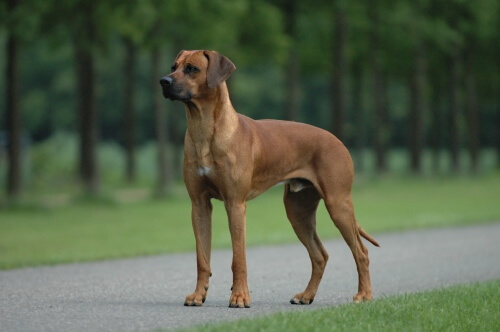The Rhodesian Ridgeback: A Brave Dog

The Rhodesian Ridgeback is a most striking dog. This animal isn’t only fast but also quite agile. Today we’d like to tell you all about this breed of dog for you to get to know them. Perhaps you’re considering adopting a dog and this could be the ideal breed for you and your family!
This type of dog dates back to the 16th century – back when Europeans invaded South Africa and first made contact with the indigenous people of an area called “Khoikhoi” –a nickname that means “stutterer” in English.
These natives had a half-domesticated wild dog whose main feature was a hair crest on their back. It grew in the opposite direction to the rest of the hair on their body and in the shape of a spear.
Aborigines used this dog for hunting and as sheepdogs. Their endurance allowed them to withstand long periods of work. In fact, they could easily withstand up to two days in the extreme temperatures of that region without food or water. Most importantly, they didn’t lose their energy.
Rhodesian Ridgeback, a fearless dog
The Rhodesian Ridgeback is a highly adaptable, silent and strong animal. Such qualities make him an excellent hunter, especially because they don’t bark. They knew no fear and, if necessary, would defend themselves against predators. They would do the same for their owners or their prey.
Despite having dogs such as Mastiffs, Terriers, and Great Danes at their disposal, the Europeans soon realized how their dogs couldn’t keep up with a Rhodesian Ridgeback. For example, they weren’t able to confront African lions, nor endure extreme temperatures.
So, they soon began to mix their breeds with South African dogs. It was no easy task. In fact, most of the new dogs didn’t their temperament and courage. The few who did were the ones who inherited the crest. Could this be the secret of the Rhodesian Ridgeback’s value?
The subjugators continued to breed dogs and carefully selected them for the desired traits until they attained what we now know as a Rhodesian Ridgeback.
Physical characteristics of a Rhodesian Ridgeback

The males can weigh between 80 and 90 pounds and measure between 24 and 27 inches. Meanwhile, females measure between 24 and 25 inches and weigh between 70 and 82 pounds.
Their hair is short; a good trait as it protects them from ticks. It’s also bright and dense, part of the characteristic beauty of this breed.
In addition, their legs are strong and straight –perhaps a fundamental part of their impressive endurance. Also, they’re muscular, agile and highly active, and quite symmetrical and athletic in their appearance.
Their fringe of hair that grows in the opposite direction to the rest of their fur is their main characteristic. For it to be purebred, the ridge must be well defined and symmetrical and get narrower towards the hip.
Their “accepted” colors are a range of tones from pale to reddish-brown. Even so, a small white spot on their chest is “allowed.”
Personality

These dogs are loyal and intelligent, although they’re not too keen on strangers. This doesn’t mean they’ll attack, only that they’ll scrutinize anyone they don’t know before they let them through.
They have a strong personality and some are quite naughty. However, they’ll protect their families all the same, making it an ideal breed for children. Also, they make great guard dogs when properly trained.
Special care
The Rhodesian Ridgeback doesn’t require any special care. Nothing different from any other dog. Do be sure to feed them a quality diet. Also, you must allow them to exercise often and to be calm and relaxed.
Socialization is very important due to this breed’s tendency to ignore strangers. The main rule for their training should always be rooted in positive reinforcement.
The Rhodesian Ridgeback is a most striking dog. This animal isn’t only fast but also quite agile. Today we’d like to tell you all about this breed of dog for you to get to know them. Perhaps you’re considering adopting a dog and this could be the ideal breed for you and your family!
This type of dog dates back to the 16th century – back when Europeans invaded South Africa and first made contact with the indigenous people of an area called “Khoikhoi” –a nickname that means “stutterer” in English.
These natives had a half-domesticated wild dog whose main feature was a hair crest on their back. It grew in the opposite direction to the rest of the hair on their body and in the shape of a spear.
Aborigines used this dog for hunting and as sheepdogs. Their endurance allowed them to withstand long periods of work. In fact, they could easily withstand up to two days in the extreme temperatures of that region without food or water. Most importantly, they didn’t lose their energy.
Rhodesian Ridgeback, a fearless dog
The Rhodesian Ridgeback is a highly adaptable, silent and strong animal. Such qualities make him an excellent hunter, especially because they don’t bark. They knew no fear and, if necessary, would defend themselves against predators. They would do the same for their owners or their prey.
Despite having dogs such as Mastiffs, Terriers, and Great Danes at their disposal, the Europeans soon realized how their dogs couldn’t keep up with a Rhodesian Ridgeback. For example, they weren’t able to confront African lions, nor endure extreme temperatures.
So, they soon began to mix their breeds with South African dogs. It was no easy task. In fact, most of the new dogs didn’t their temperament and courage. The few who did were the ones who inherited the crest. Could this be the secret of the Rhodesian Ridgeback’s value?
The subjugators continued to breed dogs and carefully selected them for the desired traits until they attained what we now know as a Rhodesian Ridgeback.
Physical characteristics of a Rhodesian Ridgeback

The males can weigh between 80 and 90 pounds and measure between 24 and 27 inches. Meanwhile, females measure between 24 and 25 inches and weigh between 70 and 82 pounds.
Their hair is short; a good trait as it protects them from ticks. It’s also bright and dense, part of the characteristic beauty of this breed.
In addition, their legs are strong and straight –perhaps a fundamental part of their impressive endurance. Also, they’re muscular, agile and highly active, and quite symmetrical and athletic in their appearance.
Their fringe of hair that grows in the opposite direction to the rest of their fur is their main characteristic. For it to be purebred, the ridge must be well defined and symmetrical and get narrower towards the hip.
Their “accepted” colors are a range of tones from pale to reddish-brown. Even so, a small white spot on their chest is “allowed.”
Personality

These dogs are loyal and intelligent, although they’re not too keen on strangers. This doesn’t mean they’ll attack, only that they’ll scrutinize anyone they don’t know before they let them through.
They have a strong personality and some are quite naughty. However, they’ll protect their families all the same, making it an ideal breed for children. Also, they make great guard dogs when properly trained.
Special care
The Rhodesian Ridgeback doesn’t require any special care. Nothing different from any other dog. Do be sure to feed them a quality diet. Also, you must allow them to exercise often and to be calm and relaxed.
Socialization is very important due to this breed’s tendency to ignore strangers. The main rule for their training should always be rooted in positive reinforcement.
This text is provided for informational purposes only and does not replace consultation with a professional. If in doubt, consult your specialist.








